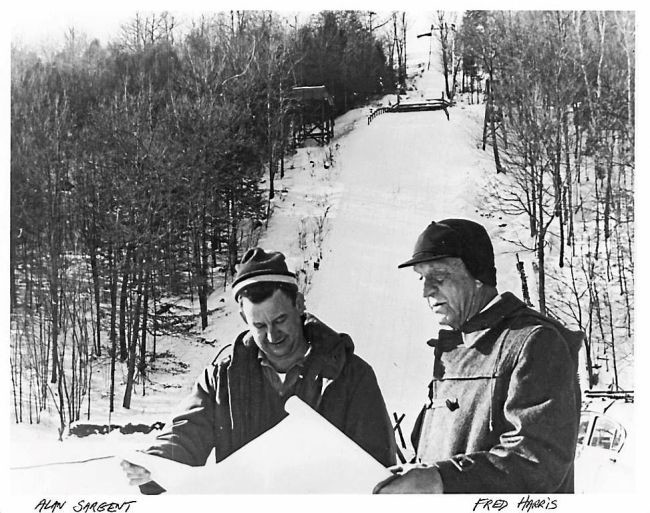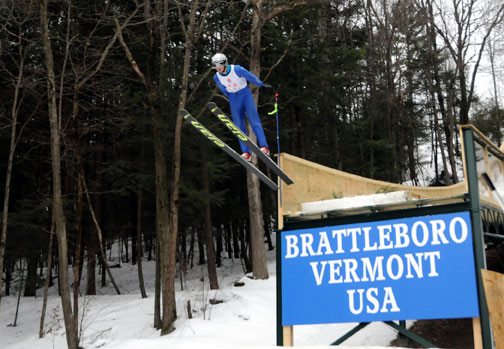For those of us who started skiing in our backyards, the first step was to find a hill to ski down. The second step was to build a jump on that hill! So it’s no surprise that in the history of skiing competitions, ski jumping pre-dates all the disciplines except cross country. The first documented ski jump was when Norwegian Olaf Rye jumped 31 feet in 1808! Similarly the first documented jumping competition where prizes were awarded was in Norway in 1866. That competition was won by Sondre Norheim who along with many other Norwegians would immigrate to the United States and bring ski jumping with them.
The growth of ski jumping in the United States is tied directly to where the Norwegian immigrants settled. Ishpeming, Michigan, was one of the locales where the Norwegian influence led to organized ski clubs and competitions in cross country and ski jumping. As such Ishpeming claims to be the birthplace of organized skiing in the United States. The National Skiing Association was founded there in 1905 and it is still home to the U.S. Ski and Snowboard Hall of Fame. That’s the answer to the unasked trivia question, “Why the hell is the Ski and Snowboard Hall of Fame in Ishpeming, Michigan?”
Ski jumping would also grow in other areas led by Norwegian immigrants. In 1910, one out of 20 Seattle residents was either born in Norway or a child of parents born in Norway. This would lead to the growth of ski clubs and ski jumping in the Pacific Northwest. Carl Howelsen would migrate from Norway to Steamboat Springs, Colorado, and build a ski jump in 1915. That ski jump is still in existence and is used for training by the U.S. Ski Team.
In the Northeast, Norwegians working in the mills around Berlin, New Hampshire, would form the Nansen Ski Club and build the Nansen ski jump which would host significant jumping events.
In Vermont, organized ski jumping began with the first Winter Carnival coordinated by James “Pops” Taylor at Vermont Academy in 1909. In 1921 Fred Harris would build a jump in Brattleboro that could host big time competitions. I’ll talk more about that jump a little later.
Stowe also built a jump in 1921 for its first Winter Carnival on Marshall Hill. That’s the sliding hill behind the Elementary school. Craig Burt and a local craftsman of Swedish descent named Sorensen were in charge of building the jump. The tower for the jump was an impressive 45 feet high.
The only problem with the jump was that the landing hill was not steep enough. Burt said that the jumpers’ skis sounded like rifle shots when they landed. One of the notable jumpers was Bing Anderson, a Norwegian from the Nansen Ski Club, and he blew out of both skis, finishing on just his boots!
Carrie Slayton shared memories of “Skiing in Moscow, Vt” in 1962 editions of the Stowe Reporter. She mentions at least 3 jumps in the Moscow area in the 1920s and 30s. In 1924 the Moscow school children organized a Winter Carnival. Slayton says, “The big event was the jumping. Clem Wilkins won first place by clearing 48 ½ feet!” By the way she mentions he was on 8’3” skis made at Pike’s Mill in the Lower Village.
She also documents that Joe Slayton of Moscow built a 39 foot ski jump in 1935. She included a picture and let’s just say that it looks as dangerous to climb up the structure as it would be to ski down it! However it must have paid off because Joe was the state ski champion in both Cross Country and Jumping!
This weekend Harris Hill in Brattleboro will celebrate its 100th Anniversary! The first jumping event there was in February 1922 and drew 3000 spectators. Through the years it hosted many major jumping events including 9 U.S. National Championships. In the early 1950s the jumping events were drawing 10,000 spectators!
By 2005 the jump had fallen into disrepair and had to be closed. However the good people of Brattleboro decided that Harris Hill was worth saving! They did it in a way that would have made Fred Harris proud – they raised the money and did the rebuild themselves. In February 2009 the only 90 meter ski jump in New England reopened to host jumpers literally from around the world. The event this weekend is expected to draw 5000 spectators!



Leave a Reply